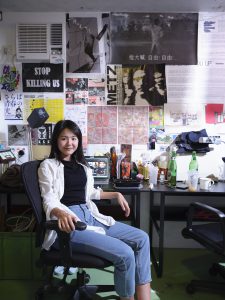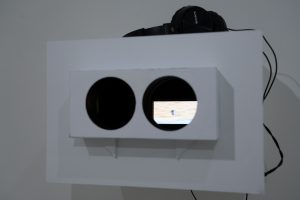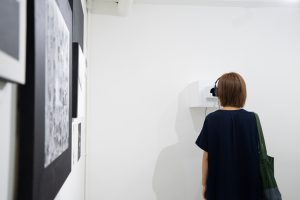artist support programme (ASP) alumni: Jess WONG Tsz-ying
「藝術家支援計劃」獲選藝術家:黃梓瑩

photo by South Ho
閱讀完整訪談 (中文) >>>
–
Jess WONG Tsz-ying A Hong Kong based artist, Jess’ practice involves moving images, sound design, and fabric painting. Interested in concept art, street art, and documentary, she constantly doubts the construction of our society. She would like to learn more about sensory cognition and the ideology that lies behind it.
Jess (b.1995) received her Bachelor of Fine Arts in Animation and Visual Effects at The Open University of Hong Kong in 2017. She was the Award Winner of Best Animated Short Film with her work Losing Sight of a Longed Place at the 54th Taipei Golden Horse Film Festival (2017).
Jess Wong Tsz-ying was supported by soundpocket’s Artist Support Programme 2018–19.
personal website >>>
Interview excerpt:
9.6.2021 (Wed)|9 pm
Online interview
◎ “through/ and through/ and through.” in ‘10 Years of ASP’: The sea is as calm after 10 years
soundpocket: Tell us about your ideas for creating “through/ and through/ and through.”. Why did you choose night swimming as the theme of the work?
Jess: For ‘10 Years of ASP’ I wanted to tell a story with animation. I did not have a concrete idea on what the story was about at the very beginning. After I talked to Yang [Founder and Artistic Director of soundpocket], I learnt more about soundpocket – some things that I had never heard about before. Then I had a small idea of what I was going to develop. We also discussed something that I was curious about, about her: her swimming experience. I know that she is very familiar with the sea, and swimming is a very relaxing activity for her, and she practises very frequently. I admire her swimming experience because I cannot swim in the sea, and I am not swimming on a regular basis. I am especially fascinated by night swimming experiences.
Yang told me about her experience swimming after one time she went to a party. I was very interested about this beginning of the whole experience – I have so many imaginary ideas about the sea, because I do not know how to swim in it, and I am scared. Knowing that she could swim in the sea in such a situation was very magical for me. Yang did not only share that one particular experience but also on how to get used to swimming in the sea, to observe the waves, and tides. I think the ebb and flow of the water affects how one swims in the water a lot, so I asked Yang how she dealt with this, her process of overcoming tides and coexisting with them?

Photo by Wong Ka-wing
I thought hard about the direction of my work shown in ‘10 Years of ASP’ – what kind of message should I bring to the audience? Is it about people who contributed to soundpocket, or others? At one point I told Vanessa [soundpocket teammate] about my idea to create a story about sounds that we have never heard in the last 10 years, and that I wanted to create an animation. But what are the sounds that we have never heard in the last 10 years? I actually don’t know much about them, but I kept trying to think of a way to present this concept.
My thinking was that soundpocket was founded more than 10 years ago, and the organization has been promoting sound and listening culture. After so many years, what are the things that we have thought about, seen, or listened to? And did we turn these thoughts into actions? Or is there anything that we have never heard, or we have forgotten? I wanted to mention such things in my work. I learnt about the reasons why Yang founded soundpocket in 2008, the journey along the way, etc. Then I expressed my ideas on these through a story about night swimming.
◎ Upstream, downstream: In search of the unworried swimming style

Photo by Wong Ka-wing
soundpocket: When you talk about the 10 years of experiences, is that on a personal level? Or is it related to the social environment?
Jess: I would like to use people who swim to represent the experience of the whole social environment. They cannot represent everything, but at least it can recount my experience and thoughts about the changing social environment. Although 10 years have passed, the waves’ patterns are the same, tidal changes go on every single day. When you swim in the sea, there must be a way to survive. The type of wave does not really matter, we should not confront it harshly, but follow our own pace. Then we would understand how little we are in the sea [social environment], but we can still reach the shore one day. I think this is a rather positive message: sometimes things seem to be horrible, but there are things that work normally. Finding a balance in handling things, but not directly confronting them with force, is also a way to survive.
soundpocket: Why did you choose to present your idea through animation?
Jess: I wanted to direct the audience to face a white wall and narrow their view when seeing the scene of the sea. This is like a person finding a hole on the wall, then he/she could see the sea from there. It’s like seeing through a telescope. I would like to create a distance between the audience and the swimmer in the animation. Viewing from a distance allows for a bigger space for the imagination, and I think this is the best and most comfortable way to see the whole development of the story.